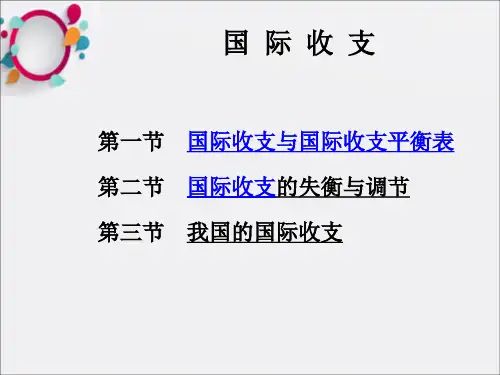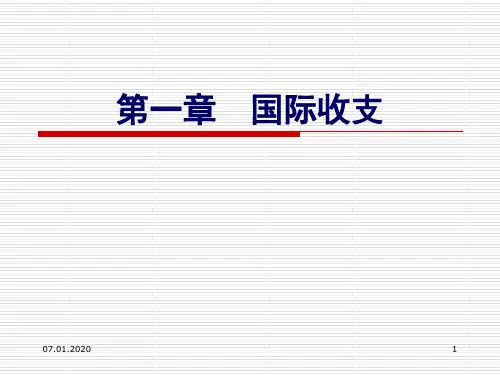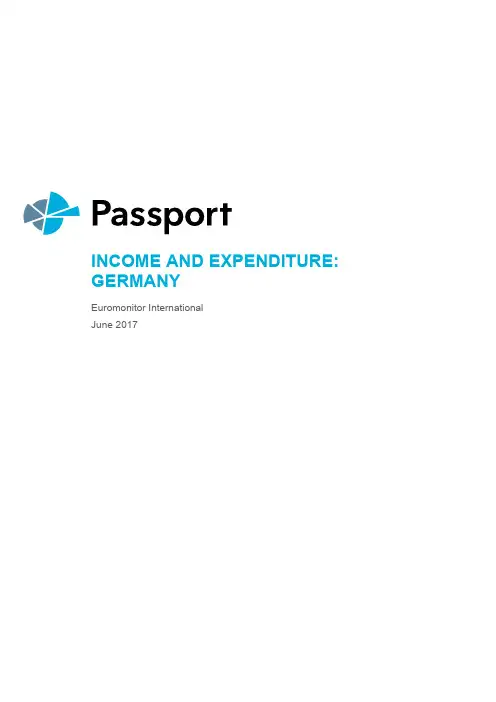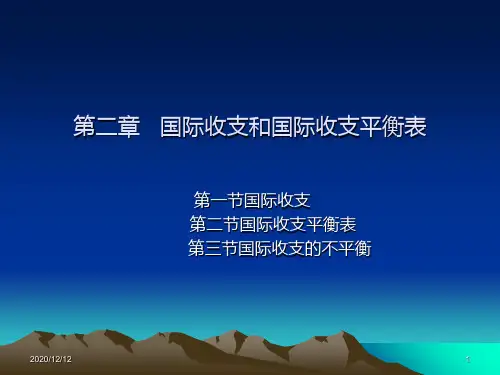德国国际收支报告ppt
- 格式:pptx
- 大小:499.02 KB
- 文档页数:21




INCOME AND EXPENDITURE: GERMANYEuromonitor InternationalJune 2017LIST OF CONTENTS AND TABLESChart 1SWOT Analysis: Germany (1)Gross Income by Age (1)Elderly Consumers Are Predominant in the Top Income Band (1)Chart 2Gross Income Distribution in Germany (2)Social Class Composition (2)Social Classes A and E Grow the Fastest (2)Chart 3Case Study on Social Class Composition: Germany (3)Chart 4Overview of Germany’s Social Classes (3)Household Income Distribution (4)Relatively Low Level of Income Inequality (4)Chart 5Household Income Distribution in Germany (4)Consumer Expenditure by Category (5)the German Consumer Market Expected To See Stable Growth (5)Chart 6Case Study on Consumer Expenditure by Category: Germany (6)Chart 7Consumer Spending in Germany (6)Consumer Expenditure by Region (7)the East-west Divide Still Exists (7)Chart 8Germany’s Consumer Market by Region (8)Consumer Expenditure by Income (8)Education was the Most Discretionary Spending Category (8)Chart 9Consumer Spending by Income Type in Germany (9)Consumer Expenditure by Household Type (9)Couples With Children Remain the Largest Consumer Market (9)Chart 10Spending by Household Type in Germany (10)Regional Comparison (10)Chart 11Germany versus Selected Western European Economies (10)INCOME AND EXPENDITURE: GERMANYReal growth in Germany’s gross income and total consumer expenditure is expected to slow down in the short term, after seeing healthy gains in 2016, on the back of employment and wage growth. Nevertheless, with a sizeable middle class, Germany continues to offer vast opportunities for consumer businesses. Rapid population ageing, shrinking household sizes, immigration and a gradual rise in income inequality will be factors affecting Germany’s income growth and spending patterns in the long run.Chart 1 SWOT Analysis: GermanySource: Euromonitor InternationalGROSS INCOME BY AGEElderly Consumers Are Predominant in the Top Income BandGerman consumers continued to see gains in their income growth in 2016, backed by economic expansion and a strong labour market:▪Germans in the age group 40-44 had the highest levels of average gross income in 2016. Nevertheless, as a share of the population in the top income band (ie individuals with an annual gross income over US$150,000), the age segment 65+ was the most predominant group. This trend is expected to rise even further in the coming years amidst the country’s rapidly ageing population, driving demand for health goods and medical services, holiday and travel services and entertainment events;▪Germany’s largest income concentration was found in the age group 45-57, due to both their relatively large average gross income levels and to the large number of individuals within this age band. Another smaller income hotspot was among the age group 25-29, primarily due to a population bulge. German mid-lifers can be targeted with a range of goods and services in family-related categories like household appliances, transport vehicles, and financial services.Meanwhile, young adults tend to be an appealing segment for categories such as clothing and footwear, communications and eating out.Chart 2 Gross Income Distribution in GermanySource: Euromonitor International from national statisticsNote: Data for 2017-2030 are forecastsSOCIAL CLASS COMPOSITIONSocial Classes A and E Grow the FastestThe lower, middle-income social class D remains the largest social class in Germany, but the two ends of the country’s social class distribution will witness strongest growth in the coming years:Social class E — the lowest income class — expanded the fastest across social classes over 2011-2016, reflecting the gradual rise in income inequality levels that Germany has experienced since the country’s reunification in 1990;Driven by the country’s rising income gap, social class E and social class A (the highest-income class) are expected to record the highest rates of expansion during the forecast period of 2017-2030. This will result in a more polarised consumer market, creating opportunities for both the luxury and budget consumer goods segments.Chart 3 Case Study on Social Class Composition: GermanySource: Euromonitor InternationalChart 4 Overview of Germany’s Social ClassesSource: Euromonitor International from national statisticsNote: Data for 2017-2030 are forecastsHOUSEHOLD INCOME DISTRIBUTIONRelatively Low Level of Income InequalityGermany’s i ncome distribution remained relatively equal on a global comparative basis, but the income gap is rising slowly:▪The highest-income decile 10 will see the strongest rise in their income through to 2030, reflecting the increasing relevance of capital income amongst Germany’s high social classes;▪While the influx of low-skilled refugees to Germany since 2015 may put some downward pressure on wage growth for low-skilled job segments, high-skilled professionals are believed to see stronger wage rises, given the country’s shortage of skilled labour. Since 2015, the German government has imposed a minimum wage law, in an effort to mitigate a further rise in income inequality and improve the social safety net for the poor.Chart 5 Household Income Distribution in GermanySource: Euromonitor International from national statisticsNote: Data for 2017-2030 are forecasts. Data are in constant US$CONSUMER EXPENDITURE BY CATEGORYthe German Consumer Market Expected To See Stable GrowthDue to rapid population ageing, consumer expenditure on health goods and medical services is forecast to see the fastest growth between 2017 and 2030:▪The German consumer market has recovered from a drop during the 2011-2013 period and recorded swift growth over 2014-2015, fuelled by monetary stimulus from the European Central Bank (ECB). Growth in total consumer expenditure has slowed down since 2015, but it is expected to stabilise in the coming years, as a result of a steady rise in income levels;▪The proportion of non-discretionary spending (expenditure on food, non-alcoholic beverages and housing) in Germany remained largely unchanged between 2011 and 2016 and is expected to rise slightly in the coming years, mainly due to a rise in housing costs across the country in the coming years;▪Education was the strongest-growing spending category between 2011 and 2016, reflecting arise in the number of youths pursuing higher education in Germany. In the long run, however,health goods and medical services are expected to show the fastest growth, fuelled by elderly consumers’ demand for outpatient services and pharmaceutical products in the country.Chart 6 Case Study on Consumer Expenditure by Category: GermanySource: Euromonitor InternationalChart 7 Consumer Spending in GermanySource: Euromonitor International from national statistics/UN/OECDNote: Data for 2017-2030 are forecastsCONSUMER EXPENDITURE BY REGIONthe East-west Divide Still ExistsThere are considerable differences in consumer spending power between the western and eastern parts of Germany:▪Being the country’s most populous state, the North Rhine-Westphalia region in the West accounts for the biggest share of total consumer expenditure in the country, and this trend will remain through to 2030;▪Baden -Württemberg, Hamburg and the capital city Berlin are forecast to show the fastest-growing consumer markets in the country between 2017 and 2030, driven by an expected strong population growth in these states, as a result of foreign immigration and the states’ dynamic economies;▪In terms of average per household spending, Bavaria had the highest spending power, backed by the strong economy. Meanwhile, due to the depopulation trend and highunemployment rates, the lowest average per household consumer expenditure is found instates in the eastern part of Germany including Mecklenburg-Vorpommern and Saxony-Anhalt.Chart 8 Germany’s Consumer Market by RegionSource: Euromonitor International from national statistics/UN/OECDNote: Data for 2017-2030 are forecastsCONSUMER EXPENDITURE BY INCOMEEducation was the Most Discretionary Spending CategoryDespite Germany’s relatively equal income distribution, there are significant differences in spending patterns across income deciles:▪While households in decile 1 allocate more than half of their spending to basic needs, including housing and food, the wealthiest households in decile 10 drive the country’s spending on categories such as education, transport and hotels and catering. Highest-income households, for example, tend to spend generously on private schools, extra tutors and overseas higher education for their children;▪Due to slow growth in consumer expenditure and a rise in housing costs, all income deciles in Germany will experience a small decline in their discretionary spending power over the 2017-2030 period.Chart 9 Consumer Spending by Income Type in GermanySource: Euromonitor International from national statistical offices/OECDCONSUMER EXPENDITURE BY HOUSEHOLD TYPECouples With Children Remain the Largest Consumer MarketCouple-with-children households represent about a third of total consumer expenditure in Germany:▪Couples with children are forecast to remain the largest consumer market with the highest average per household expenditure in Germany over the 2017-2030 period. Nevertheless, their share of total spending is set to decline gradually over the long term, as other household types see growing importance;▪Various demographic and social factors (eg population ageing, delay in marriage and rising divorce rates) will continue to boost the rise of single-person and single-parent households in Germany. These household types represent an appealing market for businesses to offerbudget products in categories like housing, health goods and medical services, and leisure and recreation.Chart 10 Spending by Household Type in GermanySource: Euromonitor International from national statistical offices/OECDREGIONAL COMPARISONChart 11 Germany versus Selected Western European EconomiesSource: Euromonitor International from national statistics。




